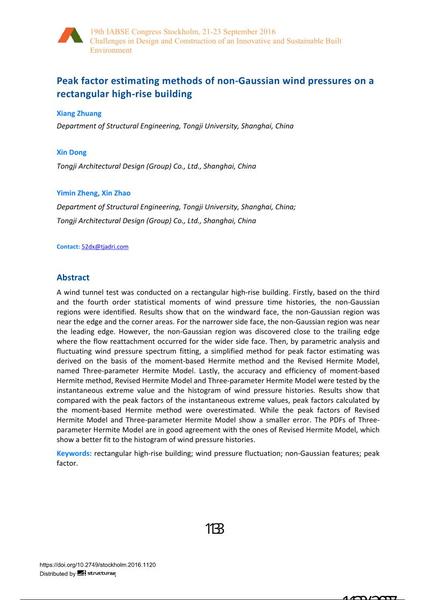Peak factor estimating methods of non-Gaussian wind pressures on a rectangular high-rise building

|
|
|||||||||||
Bibliographic Details
| Author(s): |
Xiang Zhuang
(Department of Structural Engineering, Tongji University, Shanghai, China)
Xin Dong (Tongji Architectural Design (Group) Co., Ltd., Shanghai, China) Yimin Zheng (Department of Structural Engineering, Tongji University, Shanghai, China; Tongji Architectural Design (Group) Co., Ltd., Shanghai, China) Xin Zhao (Department of Structural Engineering, Tongji University, Shanghai, China; Tongji Architectural Design (Group) Co., Ltd., Shanghai, China) |
||||
|---|---|---|---|---|---|
| Medium: | conference paper | ||||
| Language(s): | English | ||||
| Conference: | IABSE Congress: Challenges in Design and Construction of an Innovative and Sustainable Built Environment, Stockholm, Sweden, 21-23 September 2016 | ||||
| Published in: | IABSE Congress Stockholm, 2016 | ||||
|
|||||
| Page(s): | 1133-1140 | ||||
| Total no. of pages: | 8 | ||||
| Year: | 2016 | ||||
| DOI: | 10.2749/stockholm.2016.1120 | ||||
| Abstract: |
A wind tunnel test was conducted on a rectangular high-rise building. Firstly, based on the third and the fourth order statistical moments of wind pressure time histories, the non-Gaussian regions were identified. Results show that on the windward face, the non-Gaussian region was near the edge and the corner areas. For the narrower side face, the non-Gaussian region was near the leading edge. However, the non-Gaussian region was discovered close to the trailing edge where the flow reattachment occurred for the wider side face. Then, by parametric analysis and fluctuating wind pressure spectrum fitting, a simplified method for peak factor estimating was derived on the basis of the moment-based Hermite method and the Revised Hermite Model, named Three-parameter Hermite Model. Lastly, the accuracy and efficiency of moment-based Hermite method, Revised Hermite Model and Three-parameter Hermite Model were tested by the instantaneous extreme value and the histogram of wind pressure histories. Results show that compared with the peak factors of the instantaneous extreme values, peak factors calculated by the moment-based Hermite method were overestimated. While the peak factors of Revised Hermite Model and Three-parameter Hermite Model show a smaller error. The PDFs of Three- parameter Hermite Model are in good agreement with the ones of Revised Hermite Model, which show a better fit to the histogram of wind pressure histories. |
||||
| Keywords: |
rectangular high-rise building wind pressure fluctuation peak factor non-Gaussian features non-Gaussian feature
|
||||
